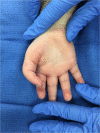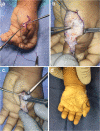Evaluation and Management of Preaxial Polydactyly
- PMID: 32472371
- PMCID: PMC7340718
- DOI: 10.1007/s12178-020-09644-w
Evaluation and Management of Preaxial Polydactyly
Abstract
Purpose of review: To provide a current review of the embryology, classification, evaluation, surgical management, and clinical outcomes related to preaxial polydactyly.
Recent findings: Recent studies include a proposed embryologic link between preaxial polydactyly and other congenital abnormalities, an evaluation of long-term postsurgical outcomes, and an examination of important predictors for postsurgical outcomes. Preaxial polydactyly, while relatively uncommon, is a complex congenital hand abnormality that requires careful preoperative classification and proper surgical intervention timing to yield optimal outcomes.
Keywords: Congenital hand anomaly; Polydactyly; Preaxial; Radial; Split thumb; Thumb duplication.
Conflict of interest statement
The authors declare that they have no conflict of interest.
Figures





Similar articles
-
An unusual case of preaxial polydactyly of the hand (triplication of the thumbs).Med J Islam Repub Iran. 2013 May;27(2):91-4. Med J Islam Repub Iran. 2013. PMID: 23741171 Free PMC article.
-
Experimental evidence that preaxial polydactyly and forearm radial deficiencies may share a common developmental origin.J Hand Surg Eur Vol. 2019 Jan;44(1):43-50. doi: 10.1177/1753193418762959. Epub 2018 Mar 27. J Hand Surg Eur Vol. 2019. PMID: 29587601
-
Thumb Hypoplasia Occurring in Patients With Preaxial Polydactyly.J Hand Surg Am. 2020 Mar;45(3):182-188. doi: 10.1016/j.jhsa.2019.11.001. Epub 2020 Jan 10. J Hand Surg Am. 2020. PMID: 31932081
-
Update of surgical treatment of polydactyly.Curr Opin Pediatr. 2023 Feb 1;35(1):124-130. doi: 10.1097/MOP.0000000000001204. Epub 2022 Nov 22. Curr Opin Pediatr. 2023. PMID: 36412268 Review.
-
Treatment of preaxial polydactyly.Hand Clin. 1992 Feb;8(1):161-75. Hand Clin. 1992. PMID: 1572920 Review.
Cited by
-
Clinical Effects of Distal Phalanges and Nail Bed Fusion in Type III Thumb Duplication.Plast Reconstr Surg Glob Open. 2025 Mar 12;13(3):e6545. doi: 10.1097/GOX.0000000000006545. eCollection 2025 Mar. Plast Reconstr Surg Glob Open. 2025. PMID: 40078620 Free PMC article.
-
Preaxial polydactyly of the foot in an adult patient diagnosed by X-ray after a trauma.Radiol Case Rep. 2023 Jan 24;18(3):1376-1379. doi: 10.1016/j.radcr.2022.12.034. eCollection 2023 Mar. Radiol Case Rep. 2023. PMID: 36818997 Free PMC article.
-
A Rare Footprint: A Case Report of Isolated Pre-Axial Fully Developed Supernumerary Toe.J Orthop Case Rep. 2025 Apr;15(4):167-170. doi: 10.13107/jocr.2025.v15.i04.5486. J Orthop Case Rep. 2025. PMID: 40212484 Free PMC article.
-
[Soft tissue balance technique by flexor pollicis longus tendon transfer for Wassel Ⅳ-D thumb duplication in children].Zhongguo Xiu Fu Chong Jian Wai Ke Za Zhi. 2022 Apr 15;36(4):395-399. doi: 10.7507/1002-1892.202110058. Zhongguo Xiu Fu Chong Jian Wai Ke Za Zhi. 2022. PMID: 35426275 Free PMC article. Chinese.
-
Thumb Duplication Surgical Treatment: Outcomes and Results.Glob Pediatr Health. 2023 Jan 20;10:2333794X221149828. doi: 10.1177/2333794X221149828. eCollection 2023. Glob Pediatr Health. 2023. PMID: 36704245 Free PMC article.
References
-
- Marks TW, Bayne LG. Polydactyly of the thumb: abnormal anatomy and treatment. J Hand Surg Am. 1978;3(2):107–116. - PubMed
-
- Wall LB, Goldfarb CA. Reconstruction for type IV radial polydactyly. J Hand Surg Am. 2015;40(9):1873–1876. - PubMed
-
- Wassel HD. The results of surgery for polydactyly of the thumb. A review. Clin Orthop Relat Res. 1969;64:175–193. - PubMed
-
- Ekblom AG, Laurell T, Arner M. Epidemiology of congenital upper limb anomalies in 562 children born in 1997 to 2007: a total population study from Stockholm, Sweden. J Hand Surg Am. 2010;35(11):1742–1754. - PubMed
Publication types
LinkOut - more resources
Full Text Sources
Research Materials

